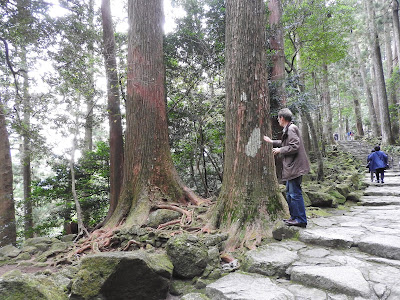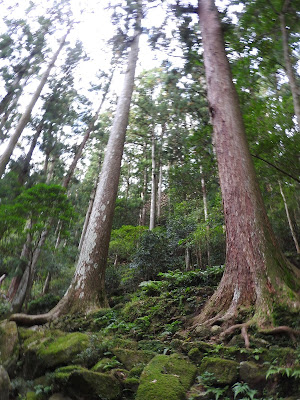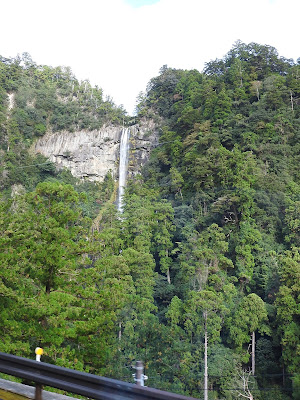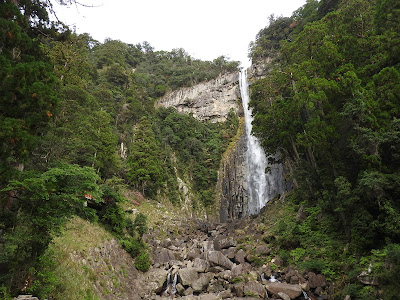 |
| 熊野・南紀旅行 11月12 - 14日 Kumano and Nanki Trip 12 -14th of November Kii Peninsula Trip |
 |
| 添乗員さん作成の予定表 実際の順番はいくつか変更になりました。 Schedule Created by Our Tour Conductor The actual order was changed. |
| 第2日目予定 / Schedule for the Second Day |
1) バスから / From Coach
2) 飛瀧神社 / Hirou Jinja Shrine
A. 滝が神様 / Waterfall is God
B. 記念写真 / Commemorative Photo
C. 諸宗教 / Various Religions
3) 落差日本1位 / Difference in Height is No1 in Japan
4) 世界遺産 / World Heritage
5) 元の世界へ / Back to Our World
1) バスから / From Coach
 |
| あれが有名な那智滝! ホテルから那智滝 (ナチノタキ)に向かいました。 バスから滝が見えて、ちょっと感動! 那智滝は、華厳滝と共に日本三名瀑に数えられています。 That is the Famous Nachi Falls! Our tour headed to Nachi Falls from the hotel. I was a little moved to see the waterfall from our coach! It is one of the three famous waterfalls in Japan along with Kegon Falls and the third, depending where you are. の那智川中流にあります。 国の名勝に指定されています。 Nachi Falls spans the middle reaches of the Nachi River in Nachikatsuura Town, This is is one of the best-known waterfalls in Japan. It has been designated as a National Place of Scenic Beauty. |
和歌山県東牟婁郡那の地図については、下記参照 (前回のブログ)。
See previous section for maps of Higashimuro-gun, Wakayama Prefecture, below.
❻ 2019年11月12.13日 橋杭岩 - 熊野・南紀旅行 / Hashigui-iwa Roc...
❻ 2019年11月12.13日 橋杭岩 - 熊野・南紀旅行 / Hashigui-iwa Roc...
 |
| 和歌山県 黄土色部分:町那智勝浦町 Wakayama Prefecture Yellow Ochre Part : Nachikatsuura chō (Nachikatsuura Town) 画像は下記より/ This from below★ |
その姿は熊野灘からも見ることができると言われています。
It is said that the Waterfalls can be seen from the Kumano Sea which is a body of water belonging to North Pacific Ocean (Philippines Sea).
2) 飛瀧神社 / Hirou Jinja Shrine
A. 滝が神様 / Waterfall is God
 |
| 登って降りる? 鳥居には飛瀧神社 (ヒロウジンジャ) と掲げられています。 飛瀧神社は、熊野那智大社の別宮。 Do we climb up and down? The torii is labeled Hirou Jinja Shrine. Hirou Jinja Shrine is an annex of Kumano Nachi Taisha Shrine. |
ある程度の距離と高低差があることによって、違う世界への、違う
空間への移動が可能になると考えます。
空間への移動が可能になると考えます。
ここの場合は、神の領域...神社はどこでも神の領域でしょうけれど、ここはまあ、かなり生粋な神の領域に感じます。
I think that it is possible to move to a different world or to a different space, by traveling a certain distance and height difference.
In this case, the realm of God ... The shrine is everywhere in the realm of God, but here feels like a fairly genuine realm of God.
 |
| 基本、木々に囲まれた道を降りてゆきます。 降りた先に.... Basically, we go down the path surrounded by trees. After getting off ... |
 |
| 真正面に滝! Waterfalls right in front of me! |
 |
| 那智滝の掛け軸 "絹本著色那智滝図" 鎌倉時代 13~14世紀 国宝 根津美術館所蔵 Hanging Scroll of "Nachi Waterfall" "Kenpon Chakushoku Nachi no Taki Zu" Kamakura period, 13th - 14th centuries National Treasure of Japan 160.7 cm x 58.8 cm Held Nezu Museum, Tokyo 画像は下記より / This from below ★ |
下記、根津美術館サイトより
"熊野三所権現のひとつである飛瀧権現(ひろうごんげん)を表す、
"熊野三所権現のひとつである飛瀧権現(ひろうごんげん)を表す、
垂迹画 (すいじゃくが) の名品。
上方の岩峰には月輪がかかり、下方には、杉の樹幹が屋根を貫く
上方の岩峰には月輪がかかり、下方には、杉の樹幹が屋根を貫く
垂迹画とは、本地垂迹 (ホンジスイジャク)説に基づく絵画です。
下記、本地垂迹についてWkiより
"本地垂迹とは、仏教が興隆した時代に発生した神仏習合思想の一つで、日本の八百万の神々は、実は様々な仏(菩薩や天部なども含む)が化身として日本の地に現れた権現(ごんげん)であるとする考えである。"
"本地垂迹とは、仏教が興隆した時代に発生した神仏習合思想の一つで、日本の八百万の神々は、実は様々な仏(菩薩や天部なども含む)が化身として日本の地に現れた権現(ごんげん)であるとする考えである。"
According to Nezu Museum's website about the Scroll,
"This depiction of the Shinto deified Nachi Waterfall is a famous example of so-called suijaku syncretic Shinto-Buddhist painting.
The painting also provides important information for research on various aspects of landscape paintings, such as the Chinese Song and Yuan dynasty painting influence seen in the use of ink and gold paint to depict the irregularities of the rocky cliff faces."
"This depiction of the Shinto deified Nachi Waterfall is a famous example of so-called suijaku syncretic Shinto-Buddhist painting.
The painting also provides important information for research on various aspects of landscape paintings, such as the Chinese Song and Yuan dynasty painting influence seen in the use of ink and gold paint to depict the irregularities of the rocky cliff faces."
Suijaku is a painting based on the theory of Honji suijaku.
Honji Suijaku is one of theories of Shinbutsu-shūgō which is the syncretism of Shinto and Buddhism.
The theory is that the Gods in Japan are actually thought to be Gongen of various Buddhas (including Bodhisattva and Tenbe) and they have appeared in Japan as incarnations.
 |
飛瀧神社 飛瀧神社は、瀧そのものを が現れた御神体 (ゴシンタイ)として、祀っています。 なので、社殿はありません。 左の建物は、売店です。 熊野の神様は元々ここでお祀りされていました。 Hirou Jinja Shrine Hirou Jinja Shrine enshrines Taki : Waterfall itself as a Goshintai : where Ōkuninushi appears. Therefore, there is no shrine building. The building on the left is a shop. Goshintai; 'Go' is the honorific prefix go- is used and 'shintai' is physical objects worshipped at or near Shinto shrine as repository in which spirits or God reside. The Gods of Kumano were originally enshrined here. 画像は下記より / This from below ★ |
B. 記念写真 / Commemorative Photo
 |
| 表面 (おおよそA4サイズ) Cover (About A4 size) |
私達の写真(下の画像)は、Rの頭に滝が注いでいるように見えて面白いです。
Rと日本国内を観光するようになってから時々記念写真を買うようになりました。
Rの在留カード申請に二人の写真が必要なことがあります。
また、現地のプロが撮影した写真が自分のものよりも見栄えが良いこともあります。
 |
| 中面 / Inside |
Our photograph, above is interesting because it looks like a waterfall is pouring into R's head.
I started to go sightseeing in Japan with R and sometimes buy commemorative photos.
R needs a photograph of us to apply for his Zairyu card : Residence card.
Also, photographs taken by local professionals look better than mine.
 |
手のひらサイズの記念写真 ツアー参加者は自動的に撮影するのですが、 無料でこのサイズの写真がいただけます。 ありがとうございます。 Palm-sized Commemorative Photo Tour participants were all photographed, and we were given this size for free. Thank you very much. |
C. 諸宗教 / Various Religions
滝そのものを神に思うことは、アニミズムに感じます。
元々、日本では、神も仏も一緒、山の神、海の神、水の神....みんな大切にし、敬ってきました。
その姿勢もかなり危うい現在ですが、今もって、日本人は自然に全ての神々、仏を受け入れていると思います。
伊勢神社は、天皇家に続く神、出雲大社は八百万の神々が信仰対象で、ここ熊野は、アニミズムを含んだ、なんでもありの神が信仰対象なのだな〜と思います。
大らかな受け入れ態勢で、好感が持ちます。
私は、自然崇拝 (アニミズム含)以外の、どこの宗教の神様も実は1つなのだと思います。
人間は、神の本意を理解できないので、ああでもない、こうでもないと自分なりに判断して、別々に神を扱い、戦ってしまっているのではないでしょうか?
愚かな人間は、上手に譲り合いができないのですね...。
熊野では、その譲り合い、匙加減が、とてもうまく統合している信仰だと思います。
これは、良い匙加減だった日本をアンバランスにする政策であったと思います。
現在では、"伝統的・自然的に育まれた固有文化や思想に対する、日本の歴史上と考えられています。
回復されているようです。
那智四十八滝回峰行の信仰は、諸宗教が入り混じったものです。
一神教の行為に怯える私は、安心します。
Various Religions
Thinking of the waterfall itself as a god feels like Animism.
Originally, in Japan, both Gods and Buddha, the God of the Mountains, the God of the Sea, the God of Water ...
This attitude is under thread nowadays, but I think that still now the Japanese naturally accept all Gods and Buddhas.
Ise Shrine is the God following the Emperor, Izumo Taisha is the object of worship of eight million Gods, and here in Kumano, the God of everything, including animism, is the object of worship.
I have a good impression with a broad acceptance system.
In my view the Gods of every religion are actually one, except Nature Worship (including animism).
Since humans cannot understand God's true intentions, they may judge that it is or it is not like that and treat them separately and fight.
Stupid humans can't make good compromises ...
I think in Kumano Region, it is a belief in which the concessions and the adjustments are very well integrated.
However, due to the Meiji government's decree on Shinbutsu bunri
; the separation of Shinto and Buddhism, the abolition of Shugendō and Haibutsu kishaku, these Gods and Buddhist beliefs were lost, and from the early Meiji era (1868 - 1912), the names and locations of the places of training became unknown.
["Shugendō is a highly syncretic religion that originated in Heian Japan.
I think this was a policy that made a well-balanced Japan unbalanced, which was a sloppy one.
It is now considered
"this was the most barbaric criminal act in Japanese history against traditional and naturally nurtured indigenous cultures and ideas"
(from Japanese Wiki, translation by me).
It seems that the lost culture has been restored to some extent by the hands of Seigantoji Temple, the '48 Waterfalls Training' with rediscovering old documents as clues.
The religion of '48 Waterfalls Training' is a mixture of various religions.
I am frightened by the acts of monotheism, so I am relieved to know of this revival.
3) 落差日本1位
Difference in Height is No1 in Japan
下記、那智滝について、南紀・熊野ジオパークネットワーク・サイトより
"那智大滝は、浸食に強い火成岩(熊野酸性火成岩類)と比較的やわらかい堆積岩(前弧海盆堆積体)の地層の境界に形成された、落差133mの滝です。"
"那智大滝は、浸食に強い火成岩(熊野酸性火成岩類)と比較的やわらかい堆積岩(前弧海盆堆積体)の地層の境界に形成された、落差133mの滝です。"
Difference in Height is No1 in Japan
From the following, Nanki・Kumano Geopark Network site (only in Japanese)
"Nachi Otaki is a waterfall with a head of 133m formed at the boundary between erosion-resistant igneous rock (Kumano acidic igneous rocks) and relatively soft sedimentary rocks (forearc basin deposits)."
(Translation by me)
 |
| 桓武天皇 (737 - 806 / 在位:781 - 806)が 滝を大穴牟遅神 (オオアナムチノカミ) と考え、今に至ります。 大穴牟遅神の別名は、大己貴命 、大国主神など、 ほか多数あります。 Emperor Kanmu (737 - 806 / reign : 781 - 806) considered the waterfall to be Ōkuninushi God and this thought continues to this day. There are many aliases for Ōkuninushi God .  落差日本1位 落差133m / 滝壺の深さ10m 石英斑岩(火成岩) Highest Waterfall Drops 133m / basin depth 10m Quartz Porphyry (Igneous rock)  落ち口 (熊野那智大社より撮影) 落ち口の幅13m 流下する水量は普通毎秒1トン程度といわれています。 Falling Mouth (Photo taken from Kumano Nachi Taisha Shrine) Falling Mouth, 13m wide It is said that the amount of water flowing down is usually about 1 ton per second. |
4) 世界遺産 / World Heritage2004年に那智滝は、世界遺産『紀伊山地の霊場と参詣道』の一部として登録されました。
『紀伊山地の霊場と参詣道』について、下記、Wikiより"日本の世界文化遺産では最大となる1万1865.3ヘクタールにおよぶ。神格化して崇める信仰が盛んな地域で、古代の都がおかれた奈良盆地近辺の人々の信仰を集めていた。"

'一の滝' が大滝 : 那智滝
那智滝とは、本来は、那智山 (ナチザン) の多くの滝のうち、
瀧篭修行(タキロウシュギョウ)の場として扱われた
48の滝(那智四十八滝)の総称でした。
'那智48滝'で、一番高いのが '一の滝'です。
この滝の上流には、'二の滝'、'三の滝'があり
総称して那智の大滝とされ、国の名勝になっています。
"Ichinotaki" ; 'First Waterfall' is Nachi Falls
Nachi Falls was originally a general term
for 'Nachi 48 Falls' that were treated as places
for Takiro Shugyo which is a training performed in waterfalls,
from among the many waterfalls on Mt. Nachi.
There are the 'Second Waterfall' and the 'Third Waterfall'
upstream of this waterfall, which are collectively called
"Nachi's Otaki" : Nachi's Big Waterfalls,
and are a National Place of Scenic Beauty.
World Heritage
 |
| '一の滝' が大滝 : 那智滝 那智滝とは、本来は、那智山 (ナチザン) の多くの滝のうち、 瀧篭修行(タキロウシュギョウ)の場として扱われた 48の滝(那智四十八滝)の総称でした。 '那智48滝'で、一番高いのが '一の滝'です。 この滝の上流には、'二の滝'、'三の滝'があり 総称して那智の大滝とされ、国の名勝になっています。 "Ichinotaki" ; 'First Waterfall' is Nachi Falls Nachi Falls was originally a general term for 'Nachi 48 Falls' that were treated as places for Takiro Shugyo which is a training performed in waterfalls, from among the many waterfalls on Mt. Nachi. There are the 'Second Waterfall' and the 'Third Waterfall' upstream of this waterfall, which are collectively called "Nachi's Otaki" : Nachi's Big Waterfalls, and are a National Place of Scenic Beauty. |
In 2004, Nachi Falls were registered as part of the World Heritage Site "Sacred Sites and Pilgrimage Routes in the Kii Mountain Range".
About "Sacred Sites and Pilgrimage Routes in the Kii Mountain Range" from the Japanese Wiki below,"It covers 11,865.3 hectares, which is the largest World Cultural Heritage Site in Japan.
The Kii Mountains have many mountains at an altitude of 1000 metres, has been a region where nature has been deified and worshiped since ancient times, and worshiped particularly by people from the nearby Nara Basin, where the ancient capital city was located. "(Translation by me)
The Kii Mountains have many mountains at an altitude of 1000 metres, has been a region where nature has been deified and worshiped since ancient times, and worshiped particularly by people from the nearby Nara Basin, where the ancient capital city was located. "
 |
| Red Circle ● : Sacred Sites and Pilgrimage Routes in the Kii Mountain Range 33°50′13″N 135°46′35″E 画像は下記より / This from below ★ |
According to Wiki about this Heritage,
It was also noted for its fusion of Shinto and Buddhist beliefs, and a well documented history of traditions over 1,200 years.
"The locations and paths for this heritage site were based on their historical and modern importance in religious pilgrimages.
It was also noted for its fusion of Shinto and Buddhist beliefs, and a well documented history of traditions over 1,200 years.
The nature scenery on the Kii peninsula was also taken into consideration, with its many streams, rivers and waterfalls.
Technically, independent structures at nominated temples and shrines were nominated for this distinction, and not the entire establishments.
 |
| 三重塔(左)と那智滝 (熊野那智大社より撮影) 英語のWikiで下のような説明があります。 "多くの修験道や添い遂げられなかった恋人たちは、 観音の楽園に生まれ変わると信じて 滝の頂上から飛び降りてきました。" そうだったのか..とちょっとびっくりして 日本語の他のサイトを探しましたが、 この記述にあたるものを見つけられませんでした。 滝が神様となって、1200年以上の間に そのようなことがあったのかもしれませんが、 それは '多くの' に匹敵する数なのか、疑問です。 Three-storied Pagoda (left) and Nachi Falls (Photo taken from Kumano Nachi Taisha Shrine) There is the following explanation on the English Wiki, "Many shugenja and star-crossed lovers have leaped from the top of the waterfall in the belief that they will be reborn into Kannon's paradise. " I was a little surprised that it was so .. I searched for other websites in Japanese, but I couldn't find anything that corresponds to this description. Something may have happened in the more than 1200 years since the waterfall became a God, but I wonder if the number could be 'Many'. |
5) 元の世界へ / Back to Our World
 |
| 降りたからには、登らなくてはなりません... We had walked down, but now we have to climb up. |
 |
立派な木々 / Magnificent Trees   1.000年前に来た人も似たような風景を 見たでしょうか? Did people who came 1,000 years ago see a similar view? |
次のセクションは、熊野那智大社です。
The next section is about Kumano Nachi Taisha Shrine.





0 件のコメント:
コメントを投稿